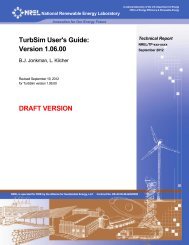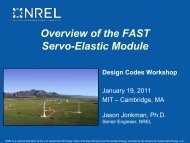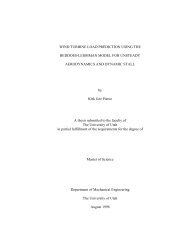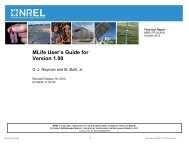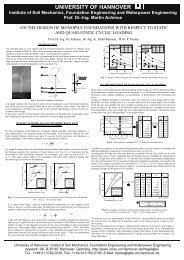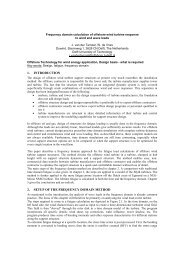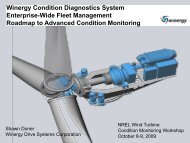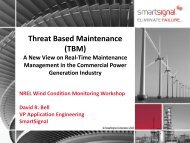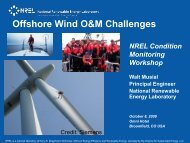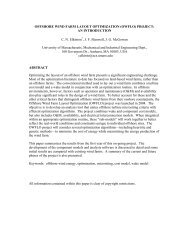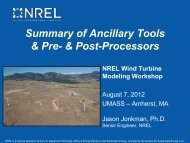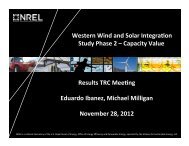the horns rev wind farm and the operational experience
the horns rev wind farm and the operational experience
the horns rev wind farm and the operational experience
- No tags were found...
You also want an ePaper? Increase the reach of your titles
YUMPU automatically turns print PDFs into web optimized ePapers that Google loves.
Copenhagen Offshore Wind 2005, 26-28 October 2005 1THE HORNS REV WIND FARM AND THE OPERATIONALEXPERIENCE WITH THE WIND FARM MAIN CONTROLLERJesper Runge KristoffersenM.Sc.EEElsam Engineering A/S, Kraftværksvej 53, DK-7000 Fredericia, DenmarkTel. +45 79233333, email: jrk@elsam-eng.dkABSTRACTThis paper describes <strong>the</strong> Horns Rev Offshore Wind Farm <strong>and</strong> <strong>operational</strong> <strong>experience</strong>s with <strong>the</strong> Wind Farm MainController. The <strong>wind</strong> <strong>farm</strong> was built in 2002 by <strong>the</strong> Danish utility group Elsam, <strong>and</strong> has now been in regular operation for along period. The <strong>wind</strong> <strong>farm</strong> was <strong>the</strong> first to be equipped with advanced centralised control of both active <strong>and</strong> reactivepower. With <strong>the</strong> Wind Farm Main Controller it is possible to operate <strong>the</strong> <strong>wind</strong> <strong>farm</strong> as a <strong>wind</strong> power plant. The paper startswith an introduction to <strong>the</strong> general features of <strong>the</strong> <strong>wind</strong> <strong>farm</strong> <strong>and</strong> main controller, <strong>and</strong> <strong>the</strong>n describes <strong>the</strong> daily <strong>operational</strong><strong>experience</strong> with <strong>the</strong> advanced control modes.KEY WORDSWind <strong>farm</strong> controller, power control, grid integration, primary <strong>and</strong> secondary control, <strong>operational</strong> <strong>experience</strong>
Copenhagen Offshore Wind 2005, 26-28 October 2005 2I. INTRODUCTIONThe Horns Rev offshore <strong>wind</strong> <strong>farm</strong> is <strong>the</strong> first <strong>wind</strong> <strong>farm</strong> built as part of <strong>the</strong> Danish Government’s offshore <strong>wind</strong> energyprogramme. It was built by <strong>the</strong> Danish utility group Elsam in 2002 <strong>and</strong> consists of 80 Vestas V80/2MW <strong>wind</strong> turbines. The<strong>wind</strong> <strong>farm</strong> is situated on a natural reef called Horns Rev in <strong>the</strong> North Sea 14 to 20 km from <strong>the</strong> shore at <strong>the</strong> westernmostpoint of Denmark.Figure 1. The Horns Rev Wind Farm seen from <strong>the</strong> air. The <strong>wind</strong> <strong>farm</strong> covers more than20 km 2In <strong>the</strong> electrical supply system, control is implemented as primary <strong>and</strong> secondary control, where <strong>the</strong> primary control acts onfast frequency deviations with <strong>the</strong> purpose of keeping equilibrium between <strong>the</strong> instantaneous power consumption <strong>and</strong>production for <strong>the</strong> area in question. For secondary control - or balance control - <strong>the</strong> area is divided into a number of controlzones, <strong>and</strong> <strong>the</strong> aim is to balance <strong>the</strong> production with <strong>the</strong> dem<strong>and</strong> within <strong>the</strong> different zones <strong>and</strong> to keep up <strong>the</strong> agreedexchange of power with o<strong>the</strong>r zones. This control form is enacted by manually issuing production schedules to <strong>the</strong> powerproducingunits in each zone. Uncontrolled production units such as large <strong>wind</strong> <strong>farm</strong>s will disturb both <strong>the</strong> instantaneousequilibrium <strong>and</strong> <strong>the</strong> balance in <strong>the</strong> grid.With <strong>the</strong> Horns Rev <strong>wind</strong> <strong>farm</strong>, a number of new concepts for overall control of active <strong>and</strong> reactive power have beenintroduced. These new concepts place stringent dem<strong>and</strong>s on <strong>the</strong> remote control system. Within <strong>the</strong> envelope area between<strong>the</strong> <strong>wind</strong> <strong>farm</strong> power curve <strong>and</strong> <strong>the</strong> available <strong>wind</strong> speed, <strong>the</strong> <strong>wind</strong> <strong>farm</strong> is able to participate in both primary <strong>and</strong> secondarycontrol. A Wind Farm Main Controller (WFMC) is installed to h<strong>and</strong>le both types of control. The WFMC is designed <strong>and</strong>developed by Elsam Engineering A/S.The WFMC includes several different control schemes to increase <strong>the</strong> flexibility of power production from <strong>the</strong> <strong>wind</strong> <strong>farm</strong>.These are introduced to ease <strong>and</strong> improve <strong>the</strong> daily operation of <strong>the</strong> grid seen from <strong>the</strong> point of view of Elsam’s centralcontrol centre. The controller receives setpoints for active <strong>and</strong> reactive power from <strong>the</strong> central control centre <strong>and</strong>afterwards distributes corresponding setpoints to <strong>the</strong> individual turbines.The paper will deal with <strong>the</strong> use of <strong>the</strong> different control forms of <strong>the</strong> WFMC.The overall conclusion is that <strong>the</strong> advanced control functions are almost indispensable for maintaining <strong>the</strong> balance in <strong>the</strong>grid, irrespective of whe<strong>the</strong>r this is done by a large producer responsible for balancing his own production or by <strong>the</strong>responsible system operator for o<strong>the</strong>r producers.II. THE HORNS REV OFFSHORE WIND FARMThe <strong>wind</strong> <strong>farm</strong> at Horns Rev is located approximately 15 km into <strong>the</strong> North Sea off <strong>the</strong> westernmost point of Denmark. Thelocation is shown in figure 2.
Copenhagen Offshore Wind 2005, 26-28 October 2005 3North SeaHorns RevDKFigure 2. The Horns Rev offshore <strong>wind</strong> <strong>farm</strong> situated between 14 <strong>and</strong> 20 km into <strong>the</strong>North SeaThe installed power is 160 MW from 80 <strong>wind</strong> turbines in an almost square pattern. The turbines are arranged along 10lines each with eight turbines. Pairs of lines form 32 MW clusters. Each cluster is connected to <strong>the</strong> offshore transformersubstation where <strong>the</strong> 33/150 kV transformer is located. The principle is illustrated in figure 3.To shoreTransformerSubstation5.5 km5.5 kmFigure 3. Connection of <strong>the</strong> turbines to <strong>the</strong> offshore transformer substationFrom <strong>the</strong> substation, a submarine cable leads to <strong>the</strong> shore where it is terminated in an existing substation.All power cables have integrated optic fibers for <strong>the</strong> remote control system.The turbines at Horns RevVestas Sc<strong>and</strong>inavian Wind Technology A/S tendered successfully for <strong>the</strong> supply of <strong>the</strong> turbines. The selected type is <strong>the</strong>Vestas V80 2 MW offshore turbine with OptiSpeed technology. The hub height is 70 metres <strong>and</strong> <strong>the</strong> rotor has a diameter of80 metres, which gives a maximum tip height of 110 metres above mean sea level. Some of <strong>the</strong> turbines are shown in figure4.The turbines are all equipped with a helihoist platform at <strong>the</strong> rear end of <strong>the</strong> nacelle. For service visits, personnel access <strong>the</strong>turbine via this platform from a helicopter. The turbines can also be accessed by boat.
Copenhagen Offshore Wind 2005, 26-28 October 2005 4Figure 4. Vestas V80 2 MW offshore turbines at Horns RevThe transformer substation at Horns RevThe transformer substation module is situated off shore <strong>and</strong> near <strong>the</strong> <strong>wind</strong> <strong>farm</strong>. The module holds a helicopter deck, astep-up transformer, 150 kV, 34 kV <strong>and</strong> communication systems as well as <strong>the</strong> low-voltage distribution system, allcontainerised. There are also facilities for service personnel <strong>and</strong> a back-up diesel generator.Figure 5. Transformer substation moduleIII. WIND FARM MAIN CONTROLLERTo make <strong>the</strong> <strong>wind</strong> <strong>farm</strong> able to participate in both primary <strong>and</strong> secondary control, a WFMC is installed. The controller isdesigned <strong>and</strong> developed by Elsam Engineering A/S in collaboration with grid specialists from Elsam <strong>and</strong> Eltra. Thepurpose of <strong>the</strong> WFMC is to make <strong>the</strong> <strong>wind</strong> <strong>farm</strong> act as a single production unit instead of 80 individual generators.The controller includes a number of control possibilities to enable Elsam to use <strong>the</strong> <strong>wind</strong> <strong>farm</strong> as a <strong>wind</strong> power plant in asimilar way as Elsam uses <strong>the</strong> conventional power plants to keep <strong>the</strong> power equilibrium as agreed on <strong>the</strong> Nordic electricpower market.Power controlThe <strong>wind</strong> <strong>farm</strong> is able to participate in <strong>the</strong> control tasks as conventional power plants, constrained only by <strong>the</strong> limitationsimposed at any time by <strong>the</strong> existing <strong>wind</strong> conditions.During periods with reduced transmission capacity in <strong>the</strong> grid (eg due to service or replacement of components in <strong>the</strong> maingrid) <strong>the</strong> <strong>wind</strong> <strong>farm</strong> is able to operate at reduced power levels with all turbines running. This is called <strong>the</strong> AbsoluteProduction Limiter.
Copenhagen Offshore Wind 2005, 26-28 October 2005 5Ano<strong>the</strong>r aspect is that <strong>the</strong> <strong>wind</strong> <strong>farm</strong> is able to participate in <strong>the</strong> regional secondary control. This is called Balance Control.Passing wea<strong>the</strong>r fronts <strong>and</strong> thunderstorms can cause large <strong>and</strong> fast variations in <strong>the</strong> power production. Obviously,decreasing <strong>wind</strong> speeds cannot be avoided, but when <strong>the</strong> <strong>wind</strong> speed increases, <strong>the</strong> <strong>wind</strong> <strong>farm</strong> is able to impose a positiverate of change (dP/dt) limitation. This is called Power Rate Limitation.In some periods it may be advantageous to run <strong>the</strong> <strong>wind</strong> <strong>farm</strong> as a spinning reserve. To make this work properly <strong>the</strong> <strong>wind</strong><strong>farm</strong> is controlled so <strong>the</strong> power production is an adjustable number of MWs below <strong>the</strong> possible power. This is called DeltaControl.The principle of all <strong>the</strong> mentioned control functions is illustrated in figure 6.PowerPossible PowerPossible Power PossiblePowerPossibleActualActualActualActualAbsolute Power LimitationBalance ControlPower Rate LimitationDelta Controltime time time timeFigure 6. Outline of <strong>the</strong> active power control functions. The plots show <strong>the</strong> possiblepower <strong>and</strong> <strong>the</strong> actual achieved power with <strong>the</strong> different control functions activeFrequency controlThe frequency control (primary control) affects <strong>the</strong> whole UCTE grid <strong>and</strong> is carried out on a proportional basis by <strong>the</strong>UCTE participants. The <strong>wind</strong> <strong>farm</strong> is able to participate in <strong>the</strong> frequency control.The implemented frequency control follows <strong>the</strong> characteristic shown in figure 7.Control b<strong>and</strong>Over frequencyMaxDead b<strong>and</strong>Dead b<strong>and</strong>MaxFrequencyErrorUnder frequencyControl b<strong>and</strong>Figure 7. Characteristic of frequency controlAll settings are adjustable, i.e. dead b<strong>and</strong>, control b<strong>and</strong> gain, <strong>and</strong> max/min.Voltage <strong>and</strong> reactive power controlThe specifications in [1] mention <strong>the</strong> operating range of <strong>the</strong> voltage at <strong>the</strong> l<strong>and</strong>-based 150 kV substation during normaloperation. In some periods <strong>the</strong> area is subjected to severe salt storms <strong>and</strong> <strong>the</strong> grid is operated at voltages as low as 130-140kV, where <strong>the</strong> normal operating voltage is 165-169 kV. The transformer on <strong>the</strong> platform has an automatic on-load tapchanger with an adjustment range of 129-177 kV.The basic requirement to reactive power compensation is that <strong>the</strong> <strong>wind</strong> <strong>farm</strong> is reactive power neutral at <strong>the</strong> 34 kVterminals of <strong>the</strong> offshore transformer. Because <strong>the</strong> turbines can both produce <strong>and</strong> absorb significant amounts of reactivepower, <strong>the</strong> <strong>wind</strong> <strong>farm</strong> is able to perform voltage control on <strong>the</strong> 150 kV side of <strong>the</strong> transformer or keep a constantproduction or absorption on <strong>the</strong> 34 kV side.CommunicationThe illustration in figure 8 shows how <strong>the</strong> WFMC communicates with <strong>the</strong> surroundings. The SCADA system isVestasOnline Professional. Parameters in <strong>the</strong> WFMC are set directly from VestasOnline. The WFMC communicates wi<strong>the</strong>ach turbine <strong>and</strong> also a measuring front end. All communication to <strong>and</strong> from <strong>the</strong> WFMC is h<strong>and</strong>led through an OPCinterface via an E<strong>the</strong>rnet TCP/IP-based network.
Copenhagen Offshore Wind 2005, 26-28 October 2005 6OPCOPCSCADA WFMC TurbinesMeasuringfront endTerminalFigure 8. Communication principle in <strong>the</strong> WFMC – <strong>the</strong> communication interface is OPCThe communication parts of <strong>the</strong> WFMC are developed in collaboration with Vestas.Based on data from <strong>the</strong> individual turbines <strong>and</strong> measured, summed data from <strong>the</strong> transformer station, <strong>the</strong> WFMCdistributes control signals back to <strong>the</strong> turbines.Within <strong>the</strong> <strong>wind</strong> speed found at any time, <strong>the</strong> <strong>wind</strong> <strong>farm</strong> is controlled as a single unit by means of <strong>the</strong> control functionsmentioned above.An essential parameter in <strong>the</strong> control structure is to know <strong>the</strong> power capability both in <strong>the</strong> individual turbines <strong>and</strong> in <strong>the</strong><strong>wind</strong> <strong>farm</strong> as a whole. Each turbine determines its own active <strong>and</strong> reactive power capability from an estimated “free <strong>wind</strong>speed” in front of <strong>the</strong> turbine. The estimation of <strong>the</strong> free <strong>wind</strong> speed is based on knowledge of <strong>the</strong> actual pitch angle, power<strong>and</strong> rotor speed.IV. OPERATIONAL EXPERIENCEWith <strong>the</strong> Horns Rev Offshore Wind Farm, it is now possible to investigate <strong>the</strong> dynamic performance of large-scale <strong>wind</strong><strong>farm</strong>s under various wea<strong>the</strong>r conditions. This brings out unique knowledge that can be used in <strong>the</strong> design <strong>and</strong> in <strong>the</strong>estimation of production from future large-scale offshore <strong>wind</strong> <strong>farm</strong>s.In several situations, large power fluctuations have been observed. The fluctuations usually appear on days when large rainshowers or thunderstorms pass <strong>the</strong> <strong>wind</strong> <strong>farm</strong>. Two of <strong>the</strong>se situations are shown in figure 9 <strong>and</strong> figure 10.16014018/1-2005 - 5 min meanHorns Rev120100Power [MW]80604020Onshore turbinesTime [HH:MM]000:00 06:00 12:00 18:00 00:00Figure 9. Power fluctuations during a day with many rain showers
Copenhagen Offshore Wind 2005, 26-28 October 2005 716013/3-2005 - 5 min meanHorns Rev140120100Power [MW]806040200Onshore turbinesTime [HH:MM]00:00 06:00 12:00 18:00 00:00Figure 10. Power fluctuations during a day with many rain showersThe first plot is from 18 January 2005, <strong>and</strong> <strong>the</strong> second is from 13 March 2005. Every dot in <strong>the</strong> plot represents a 5-minutemean value. The upper curve is <strong>the</strong> production at Horns Rev, while <strong>the</strong> lower curve is <strong>the</strong> production from a number ofturbines placed on shore all over Jutl<strong>and</strong> <strong>and</strong> Funen. Compared to <strong>the</strong> production from <strong>the</strong> onshore turbines in <strong>the</strong> sameperiod, <strong>the</strong> production from Horns Rev is quite fluctuating. The conclusion is that placing a lot of <strong>wind</strong> turbines in a fairlysmall area may, in some cases, result in large power fluctuations due to local wea<strong>the</strong>r situations. To some extent, <strong>the</strong>sefluctuations can be h<strong>and</strong>led with <strong>the</strong> WFMC by using <strong>the</strong> Power Rate Limiter.On 20 January 2005, <strong>the</strong> <strong>wind</strong> speed increased to a level just above 25 m/s almost instantly across <strong>the</strong> whole <strong>wind</strong> <strong>farm</strong>. Ameasurement of this event is shown in figure 11.2000200Turbine power [kW]150010005000WFMC powerreservation forfrequency control150100500Total power [MW]-500-5002:30:00 02:35:00 02:40:00 02:45:00 02:50:00 02:55:00 03:00:00Figure 11. Shutdown of <strong>the</strong> turbines because <strong>the</strong> <strong>wind</strong> speed exceeds 25m/s. The plotshows <strong>the</strong> production from <strong>the</strong> individual turbines as well as <strong>the</strong> total power from <strong>the</strong>whole <strong>wind</strong> <strong>farm</strong>.This caused all turbines to shut down within a few minutes due to high <strong>wind</strong> speed. Then a few minutes later, <strong>the</strong> <strong>wind</strong>speed fell below 25 m/s again, <strong>and</strong> <strong>the</strong> turbines started up again, one by one. This caused <strong>the</strong> whole <strong>wind</strong> <strong>farm</strong> to go from
Copenhagen Offshore Wind 2005, 26-28 October 2005 9180160140120SetpointPossible powerPower [MW]10080604020Actual powerTime [hh:mm]000:00 02:00 04:00 06:00 08:00 10:00 12:00 14:00Figure 14. Balance control <strong>and</strong> reservation for frequency control at <strong>the</strong> same timeAll <strong>the</strong> situations mentioned above illustrate that <strong>the</strong> advanced control functions in <strong>the</strong> WFMC are almost indispensable formaintaining balance in <strong>the</strong> grid, irrespective of whe<strong>the</strong>r this is done by a large producer responsible for balancing his ownproduction or by <strong>the</strong> responsible system operator for o<strong>the</strong>r producers.V. CONCLUSIONTo manage requirements to power control, a Wind Farm Main Controller (WFMC) has been developed. Itcommunicates with <strong>the</strong> turbines <strong>and</strong> <strong>the</strong> remote control system via an E<strong>the</strong>rnet TCP/IP-based network. The WFMC isdesigned <strong>and</strong> developed by Elsam Engineering A/S <strong>and</strong> makes <strong>the</strong> <strong>wind</strong> <strong>farm</strong> able to act as a <strong>wind</strong> power plant. With <strong>the</strong>WFMC <strong>the</strong> <strong>wind</strong> <strong>farm</strong> is able to h<strong>and</strong>le both primary <strong>and</strong> secondary control on <strong>the</strong> same level as conventional powerplants.The controller includes a number of control possibilities to enable Elsam to use <strong>the</strong> <strong>wind</strong> <strong>farm</strong> as a <strong>wind</strong> power plant ina similar way as Elsam uses <strong>the</strong> conventional power plants to keep <strong>the</strong> power equilibrium as agreed on <strong>the</strong> Nordic electricpower market.The advanced control functions in <strong>the</strong> WFMC are almost indispensable for maintaining balance in <strong>the</strong> grid, irrespective ofwhe<strong>the</strong>r this is done by a large producer responsible for balancing his own production or by <strong>the</strong> responsible systemoperator for o<strong>the</strong>r producers.VI. REFERENCES[1] Eltra, “Specifications for Connecting Wind Farms to <strong>the</strong> Transmission Network”, second edition, ELT1999-411a,www.eltra.dk/media/1030_12321.pdf.VII. AUTHOR BIOGRAPHYJesper Runge Kristoffersen earned his Master degree in electrical engineering in 1996 from Aalborg University, Institute of Electrical Engineering inDenmark. In <strong>the</strong> period 1996-1999 he was with Danfoss Drives A/S in Denmark as a research engineer. Since 1999 he has been with Elsam EngineeringA/S in Denmark as a control engineer dedicated to <strong>the</strong> design <strong>and</strong> analysis of advanced control strategies, simulation, <strong>and</strong> control of power systems. Hismain field of activity is now within <strong>wind</strong> turbines <strong>and</strong> <strong>wind</strong> <strong>farm</strong>s. He has been <strong>the</strong> key figure in <strong>the</strong> design, development <strong>and</strong> implementation of <strong>the</strong>Wind Farm Main Controller for <strong>the</strong> Horns Rev Offshore Wind Farm.



